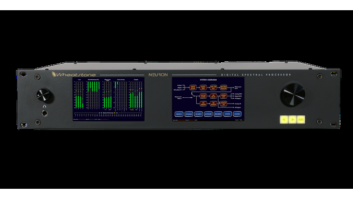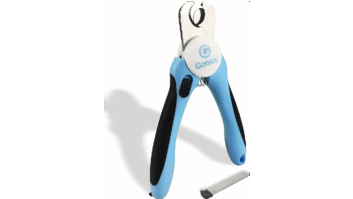One of the benefits of doing contract engineering and project work is the breadth of experience each job brings. No two jobs are the same, and each brings a new twist to “the same old task.”
Years of this kind of experience helped Mike Patton of Michael Patton Associates in Baton Rouge, La., develop a list of emergency transmitter site needs that he shares with Workbench readers.
(click thumbnail)Fig. 1: Expanding foam can be used to seal coax and control pipes at tower buildings.
The first sub-category is “Emergency.” These items include a first-aid kit and a fire extinguisher. Mike recommends that you make sure the fire extinguisher is a carbon dioxide or Halon type, and not the dry chemical kind. Some fool will select the dry chemical extinguisher, and ruin your equipment as well as put out the fire!
Two or three gallons of clean potable water is helpful. Storing the water in one-gallon plastic jugs makes them easy to carry and store.
Add to the emergency list a fluorescent trouble lamp, a flashlight with spare batteries and bulb. Place the flashlight near the door, so it can be reached if the power is out, which will probably be the only time the flashlight is used.
To Mike’s emergency list, I would add a change of clothes and some cans of Spaghetti-Os. Also include a blanket, and if you want to get fancy, a can of Sterno brand chafing fuel and some matches.
If it sounds like you’re preparing for a camping trip, keep in mind that you could be snowed in for several days. It’s not an experience I’d wish on anyone, but with a little planning, it’s not unbearable.
(click thumbnail)Fig. 2: The foam gives a good seal and is easier to install than PVC pipe.
When I was doing contract work, we equipped some remote transmitter sites with fold-up cots and blankets. The cots were on sale for less than $10 at a surplus center – good insurance.
Many of these items can be added to the trunk of your car, too. After all, you might not make it to the remote transmitter site, so camping in your car with a few comforts isn’t the end of the world.
The idea here is to think ahead.


. . .
Cleaning supplies are next, including isopropyl alcohol. Note, this is not rubbing alcohol, which is 30-percent water. You can buy gallon-size containers of alcohol at a medical supply store. Pick up a box of clean rags as well as paper towels and toilet paper. A spray cleaner like Formula 409 brand is helpful.
Waterless hand cleaner can come in handy, along with a small vacuum and brush/dustpan. Bug spray, ant/roach/rat poison and a serious herbicide are useful.
An assortment of lubricants should be included, ranging from WD-40 or similar brand to a light machine oil and grease. Add a tube of liquid graphite for lubricating padlocks used at the tower fences.
. . .
(click thumbnail)Fig. 3: Be on the lookout for exposed radials.In a category of their own are caulk and other sealers. The expanding foam sealant seen in Fig. 1 was used by Multicultural’s Chief Engineer Mike Gilbert in Blane, Wash., to seal coax and control pipes leaving his tower coupling buildings.
Older lines were treated the same way in Figure 2. Because these lines were existing to the building, it was not practical to encase them in PVC pipe. The expandable foam provides a good seal, which can always be removed to add or remove cables or line.

. . .
Emergency tools can help you make a good impression. We’re talking basic screwdrivers, pliers, wrenches – enough tools to make most repairs if you get called out without your “real” toolbox.
This may seem like a high-odds situation, but it’s been Mike’s experience that if you can go directly from wherever you are and make good things happen, without detours for keys, tools and so forth, your resourcefulness will be remembered by good general managers.
The basic tool kit is helpful if another engineer or non-engineer arrives at the site instead of you. One of the biggest issues with tools is keeping them put. Nicely said, they tend to want to walk off.
To identify tools, we used that multi-color plastic to dip tool handles. There are enough colors to keep even the most ambitious contract engineer with a different color for each station.
Emergency tools should include an Xcelite-brand “greenie,” Phillips and slotted screwdrivers, a Crescent or similar brand wrench, and Channellock or similar brand pliers. A set of Allen wrenches is invaluable. Visit a welding supply store and buy a combo “air fitting” wrench, to handle nitrogen tank fittings.
Soldering irons, particularly the gas-fired models, are getting cheap enough that one can be added to each site. If you buy the fuel-fired iron, include some spare fuel. Don’t forget the solder and a cheap solder sucker or wick.
A digital volt meter is another tool with a reasonable price tag. Even the cheapest of DVMs can be useful in diagnosing a problem, and perhaps getting you back on the air. Don’t forget the extension cord and include a couple of lengths.
I visited a site once that was experiencing air conditioner problems. The extension cord was not long enough to get to the air handler. Talk about frustration with a trouble lamp!
Also consider one of those little ceramic heat boxes. The transmitter may keep the building warm when it is running, but when the glow leaves the tubes, that room can get mighty cold.
Along those lines, a small box fan can be useful. If a driver or other fan-cooled equipment loses a fan, aiming a box fan at the equipment to be cooled may resurrect the equipment.
Besides, if the site is not air conditioned, a box fan can help keep the room cool, making for a better work environment.
. . .
We’ll continue Mike’s list in the next column.
Until then, take a walk around your AM site, looking at the ground as you walk. If you uncover exposed ground radials, mark them so you can find them later and arrange to get them covered up.
Not only will disruption of the ground system ruin your station’s coverage, the exposed radials will earn you a violation from your friendly FCC field inspector.
Submissions for this column are encouraged, and qualify for SBE recertification credit. Fax your submission to (703) 323-8044, or send e-mail to [email protected].







